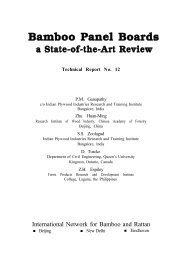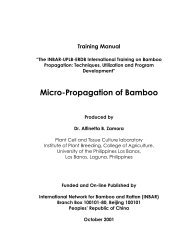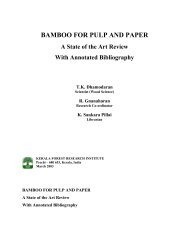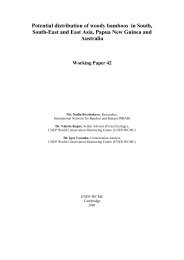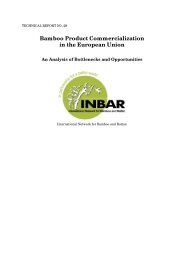The Bamboo and Rattan Sectors in Asia: an Analysis of ... - INBAR
The Bamboo and Rattan Sectors in Asia: an Analysis of ... - INBAR
The Bamboo and Rattan Sectors in Asia: an Analysis of ... - INBAR
You also want an ePaper? Increase the reach of your titles
YUMPU automatically turns print PDFs into web optimized ePapers that Google loves.
experience that seldom results <strong>in</strong> success. Moreover, forest r<strong>an</strong>gers <strong><strong>an</strong>d</strong> guards seem<br />
to disregard the licences even when they are gr<strong>an</strong>ted, dem<strong><strong>an</strong>d</strong><strong>in</strong>g bribes. <strong>The</strong>refore,<br />
people prefer to harvest bamboo illegally, remov<strong>in</strong>g it from the forest <strong>in</strong> small head<br />
loads at the risk <strong>of</strong> punishment (a 'f<strong>in</strong>e').<br />
<strong>Bamboo</strong> craft workers prefer the cultivated bamboo, which is straighter, has<br />
longer <strong>in</strong>ternodes <strong><strong>an</strong>d</strong> is easier to split <strong><strong>an</strong>d</strong> work with. Non-tribal people own most<br />
<strong>of</strong> the cultivated bamboo <strong>in</strong> the area (75%), though two <strong>of</strong> the four tribal groups <strong>in</strong><br />
the area also cultivate some. <strong>The</strong>re are three ways <strong>in</strong> which a craftsperson c<strong>an</strong> get<br />
cultivated bamboo:<br />
1. Small sales ---- up to five culms may be bought at one time. It is paid for <strong>in</strong><br />
cash <strong><strong>an</strong>d</strong> tr<strong>an</strong>sported by the craftsperson as a head load. <strong>The</strong> culms are selected by<br />
the buyer but cut <strong><strong>an</strong>d</strong> extracted by the owner <strong>of</strong> the st<strong><strong>an</strong>d</strong>.<br />
2. Leas<strong>in</strong>g a st<strong><strong>an</strong>d</strong> ---- a craftsperson may take a bamboo st<strong><strong>an</strong>d</strong> on <strong>an</strong>nual lease,<br />
pay<strong>in</strong>g rent <strong>in</strong> <strong>in</strong>stallments. Small qu<strong>an</strong>tities <strong>of</strong> bamboo are extracted as needed by<br />
the craftsperson. <strong>The</strong> bamboo is tr<strong>an</strong>sported as head load or by bullock cart. This<br />
mech<strong>an</strong>ism tends to result <strong>in</strong> lower prices per culm, <strong><strong>an</strong>d</strong> st<strong><strong>an</strong>d</strong> owners are reluct<strong>an</strong>t<br />
to enter <strong>in</strong>to such lease agreements as they fear reduced future yields from improper<br />
harvest<strong>in</strong>g.<br />
3. Large sales ---- there are about 20 tribal villages that specialize <strong>in</strong> bamboo<br />
crafts. <strong>The</strong>y require large supplies on a regular basis. For example, a village <strong>of</strong> 125<br />
families consumes three truckloads (800 culms per load) every week. Hav<strong>in</strong>g exhausted<br />
resources <strong>in</strong> their locality, they are forced to tr<strong>an</strong>sport raw material from long dist<strong>an</strong>ces,<br />
<strong><strong>an</strong>d</strong> m<strong>an</strong>y purchase two-three truckloads at a time.<br />
Tribal people, especially the Thakurs (95%), do most bamboo work. Every Thakur<br />
family has at least one member who is familiar with bamboo work, which is mostly<br />
done around the house, <strong>in</strong> courtyards or ver<strong><strong>an</strong>d</strong>ahs. <strong>The</strong> artis<strong>an</strong>s <strong><strong>an</strong>d</strong> the users typically<br />
live with<strong>in</strong> the same general vic<strong>in</strong>ity.<br />
<strong>Bamboo</strong> works is done dur<strong>in</strong>g le<strong>an</strong> periods <strong>in</strong> the agricultural season <strong><strong>an</strong>d</strong><br />
whenever time permits. <strong>The</strong> products are ma<strong>in</strong>ly for household use or barter with<br />
neighbors. Surplus products are bartered or sold <strong>in</strong> the market. Most craft workers<br />
are 45-70 years <strong>of</strong> age, the women <strong><strong>an</strong>d</strong> the younger men hav<strong>in</strong>g m<strong>an</strong>y other more<br />
press<strong>in</strong>g occupations. Younger people are less <strong>in</strong>terested <strong>in</strong> tak<strong>in</strong>g up bamboo crafts.<br />
Other occupations <strong>in</strong>clude farm<strong>in</strong>g, which takes up about 50% <strong>of</strong> peoples' time on<br />
average, <strong><strong>an</strong>d</strong> hunt<strong>in</strong>g <strong><strong>an</strong>d</strong> gather<strong>in</strong>g. <strong>Bamboo</strong> craft takes up 20% their time, <strong><strong>an</strong>d</strong><br />
generates about 8% <strong>of</strong> the total <strong>in</strong>come, plus subst<strong>an</strong>tial unqu<strong>an</strong>tified utility value.<br />
<strong>Bamboo</strong> products <strong>in</strong>clude the very import<strong>an</strong>t fish traps <strong><strong>an</strong>d</strong> weirs, a wide variety<br />
<strong>of</strong> baskets <strong><strong>an</strong>d</strong> conta<strong>in</strong>ers, <strong><strong>an</strong>d</strong> bows <strong><strong>an</strong>d</strong> arrows. <strong>Bamboo</strong> is also <strong>an</strong> import<strong>an</strong>t material<br />
<strong>in</strong> build<strong>in</strong>g houses, <strong>an</strong>imal sheds <strong><strong>an</strong>d</strong> fences, <strong><strong>an</strong>d</strong> bullock carts. Simple tools ---- a<br />
machete <strong><strong>an</strong>d</strong> perhaps a small chisel ---- <strong><strong>an</strong>d</strong> technology are employed. <strong>Bamboo</strong> baskets<br />
17



